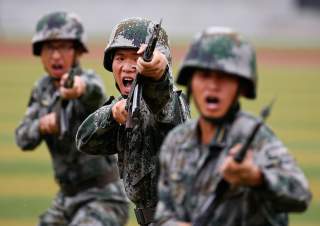The Case for Congagement with China
The Trump administration should not simply engage or contain China. It needs to blend the two together.
The prevention-plus-containment avenue faces similar limitations. The goal of this approach would be to stymie China’s power relative to America’s. In this view, the United States would not just strengthen its own overall economic and military power, but also seek to contain and weaken China’s. It would also demonstrate resolve by opposing hostile Chinese policies. The United States would bolster existing alliances, focus them on counterbalancing China, and forge new alliances and partnerships. Washington would oppose China’s OBOR policies and start limiting U.S. and allied markets to Chinese exports, so as to slow Beijing’s economic growth. It might also explore ways to more effectively support those Chinese who seek political reform, greater local autonomy and human rights. Washington would also redouble efforts to thwart Chinese theft of U.S. technological secrets.
The weakness of this approach lies in its assumption that China is inevitably on course to become a hostile global rival—a self-fulfilling prophecy. This vision also imperils potential Chinese cooperation, which could benefit the United States in dealing with North Korea, for instance. And it jeopardizes the considerable economic benefits the United States could derive from engagement.
In addition, it would be a difficult sell domestically. It would require mobilizing national energy on the basis of predictions that are pessimistic and uncertain. A policy of prevention plus containment would, moreover, require cooperation from regional allies and from most of the world’s other advanced industrial countries.
For all these reasons, the Trump administration needs a different strategy, one that could accomplish three things: preserve the hope inherent in engagement; preclude Chinese domination of Asia, limiting the relative growth of Chinese power along the way; and hedge against a strong China challenging U.S. interests. I propose a strategy of “congagement”—a mix of containment and engagement.
The Trump administration should embrace this new tack, tilting toward containment without abandoning engagement. The goal would be to plausibly convince the Chinese that while the United States is open to cooperation and mutual accommodation, American actions and messaging should aim at convincing the Chinese leaders that a push for hegemony would be resisted by the United States and its allies and partners, including other major regional powers.
Under congagement, the United States would adopt the following twelve tenets:
1) Strengthen America’s overall economic and military power to maintain a favorable global position;
2) Maintain America’s technological lead and discourage friends and allies from contributing to the growth of Chinese military capabilities by strengthening existing export controls that restrict access to Western technology;
3) Pursue a balance-of-power strategy in Asia, by encouraging U.S. allies and partners to build up their military capabilities and to cooperate among themselves to prevent Chinese regional hegemony;
4) Seek to strengthen its own relative capabilities in Asia so it can play the role of balancer and avoid facing a fait accompli when a critical U.S. interest is threatened—for example, by forcing the United States to risk major escalation and high casualties to reinstate the status quo;
5) Dissuade Taiwan from reuniting with the mainland;
6) Use access to American markets and those of regional allies—on which Chinese prosperity depends—as leverage to condition China’s behavior;
7) Rebalance trade to reduce the huge trade deficit;
8) To preserve its technological advantage and preclude new or increased vulnerabilities, review existing agreements with allies and partners, to update and add necessary steps to protect the stealing of technology by the Chinese and avoid the transfer of sensitive technology;
9) At a minimum maintain, but preferably expand, political interaction, military-to-military relations and cultural ties with China;
10) Adjust economic relations by insisting on reciprocity, such as rebalanced trade relations that reduce the huge balance-of-trade deficit;
11) Enhance cooperation on regional issues, including North Korea and terrorism;
12) To increase regional cooperation, crisis prevention and crisis management, encourage an OSCE-type organization in the Asian region with Chinese and U.S. participation. The East Asia Summit might be the best candidate to evolve into such a role, because it has the right membership, but it will need to be properly institutionalized and provided with the right mandate.
This congagement strategy would clarify to Beijing that it is best served by pursuing its interests without undermining the international system. It would communicate to China the potential costs of turning hostile by demonstrating that the United States is prepared to protect its interests. It also would highlight that the United States will reciprocate positive Chinese actions. A congagement strategy would provide the flexibility to adjust the balance between engagement and containment, depending on the state of Chinese capabilities, objectives, policies and actions. Chinese cooperation on security and economic issues would invite more engagement. Conversely, inadequate cooperation on, say, North Korea, aggressiveness in the South China Sea and bellicosity on Taiwan would trigger a tilt toward containment.
A combination of containment and engagement promises a superior approach to protecting American interests.
Zalmay Khalilzad is a counselor at CSIS. A former director of policy planning at the Pentagon, he served as U.S. ambassador to Afghanistan, Iraq and the UN. He is the author of The Envoy: From Kabul to the White House: My Journey through a Turbulent World. He would like to thank Jacqueline Newmyer Deal, Marin Strmecki and Ashley Tellis for their assistance. An earlier version of this essay was published in the American Conservative. Khalilzad originally proposed “Congagement” in 1999 as an analyst at the RAND Corporation.
This essay was published in the July/August 2017 print magazine under the headline “The Case for Congagement.”

